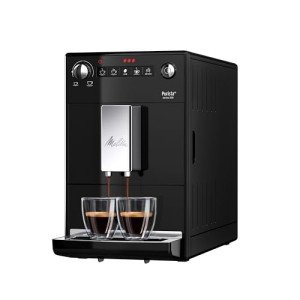Heat Exchange Espresso Machines: A Comprehensive Guide
Espresso machines have progressed substantially over the years, catering to the needs of home baristas and coffee professionals alike. Among these machines, heat exchange espresso machines have gotten popularity due to their capability to provide constant performance and extraordinary brew quality. In this short article, we will explore the operations, advantages, and crucial functions of heat exchange espresso machines, supplying an extensive understanding for both possible purchasers and coffee lovers.
Comprehending Heat Exchange Technology
Heat exchange espresso machines run on an unique concept that permits synchronised water heating for brewing and steaming. They are geared up with a single boiler that makes use of a heat exchanger system. This feature is considerable as it enables users to brew espresso while steaming milk concurrently, promoting efficiency in the coffee-making process.
How Does a Heat Exchange Espresso Machine Work?
The procedure begins with the machine's water inlet filling the boiler. As the water warms up, it turns to steam. The ingenious heat exchanger uses hot steam to heat additional water in a different passage created particularly for the brew group. This indicates that water can reach the ideal brewing temperature level without waiting for the boiler to change. The crucial actions include:
- Water Fill: Water is drawn into the boiler.
- Heating Process: The boiler warms up as water is transformed into steam.
- Heat Exchange: Steam heats water in the heat exchanger tube.
- Developing: Water from the heat exchanger is pushed through coffee grounds, extracting the flavors required for a rich espresso.
This procedure enables quick temperature level adjustments and improved coffee extraction.
Benefits of Heat Exchange Espresso Machines
Heat exchange espresso machines provide several advantages, especially for those looking to maximize their coffee experience. Here are some essential benefits:
- Simultaneous Brewing and Steaming: Users can brew espresso while steaming milk, making it perfect for hectic coffee shops and home baristas who value performance.
- Temperature level Stability: The boiler's steam pressure helps preserve a stable temperature level, which is important for constant espresso extraction.
- Flexibility: The style enables for quick switching between developing and steaming, making it easier to create various coffee beverages, from lattes to cappuccinos.
- Easy to use: Models typically come with accessible controls, making it practical for both newbies and skilled baristas to produce quality drinks.
- Professional Quality: Heat exchange machines are often used in commercial settings, supplying users with high-quality brewing efficiency in the house.
Secret Features to Look for in Heat Exchange Espresso Machines
When considering the purchase of a heat exchange espresso machine, there are several features that a person must consider:
- Build Quality: Look for machines made of long lasting materials, such as stainless steel or brass, making sure durability.
- Boiler Size: A larger boiler will hold more water and sustain higher output in time.
- PID Temperature Control: This function assists maintain constant brew temperatures, which can boost the coffee-making process.
- Group Head Design: Machines with a saturated or semi-saturated group head supply better temperature level stability.
- Alleviate of Use: User-friendly user interfaces and intuitive controls boost the total experience for baristas at all ability levels.
- Steam Wand Quality: A good steam wand with correct insulation and versatility enables much better texturing of milk.
- Water Reservoir Size: Depending on your requirements, think about how often you wish to fill up the water reservoir.
Comparison of Popular Heat Exchange Espresso Machines
To better understand the alternatives available in the market, below is a comparison table of some popular heat exchange espresso machines:
| Machine Model | Boiler Size | PID Control | Price Range | User Ratings |
|---|---|---|---|---|
| Profitec Pro 700 | 2.0 L | Yes | ₤ 2,000-₤ 2,500 | 9.5/ 10 |
| Rocket Espresso R58 | 1.8 L | Yes | ₤ 2,400-₤ 2,800 | 9.4/ 10 |
| Elekta Bianca | 1.8 L | Yes | ₤ 2,500-₤ 3,000 | 9.6/ 10 |
| La Spaziale S1 Vivaldi II | 1.5 L | Yes | ₤ 1,800-₤ 2,200 | 9.2/ 10 |
| Bezzera Magica | 1.2 L | No | ₤ 1,600-₤ 1,800 | 9.0/ 10 |
FAQs About Heat Exchange Espresso Machines
What is the primary difference between a heat exchange and a dual boiler espresso machine?
While both types can brew espresso and steam milk at the exact same time, dual boiler machines have different boilers for developing and steaming. On index , heat exchange machines use a single boiler and a heat exchanger to attain the same function.
Are heat exchange machines appropriate for newbies?
Yes! Numerous heat exchange machines are designed with user-friendly features, making them available for novices. With correct guidance and practice, users can quickly produce quality espresso.
What kind of maintenance do heat exchange espresso machines need?
Regular maintenance consists of descaling, cleaning the boiler, inspecting seals and gaskets, and keeping the group head tidy. Routine maintenance guarantees longevity and consistent performance.
Can I use a heat exchange machine for various kinds of coffee drinks?
Definitely! Heat exchange machines allow users to develop a range of coffee beverages, consisting of espresso, lattes, cappuccinos, and more.
Heat exchange espresso machines represent a blend of innovation and custom, offering coffee enthusiasts with the tools needed for crafting the perfect cup. Their ability to all at once brew and steam, combined with exact temperature level control, makes them a compelling option for both home baristas and professionals. With the best knowledge on functions and maintenance, users can unlock a world of beautiful coffee experiences, making sure that each sip is as wonderful as the last.

